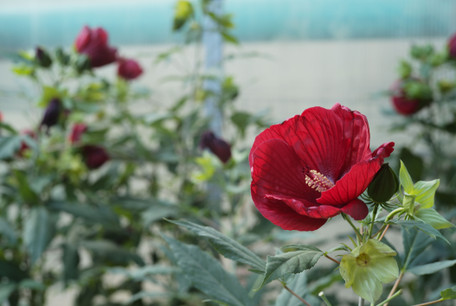Hardy Hibiscus
Posted by Aaron Barton on Aug 1st 2022
Hardy Hibiscus
Hibiscus, of the mallow family, Malvaceae, are some of the most impressive summer tropical plants, boasting massive colorful blooms and wonderful aromas perfect for sunny summer patios, though these Hibiscus surely do not get along well with our Minnesota winters. While it is hard to imagine a plant anywhere near as stunning that could survive through thirty below temps and blizzard conditions, you may be surprised (and delighted!) to learn there are perennial hibiscus hardy for right here in Minnesota! Hardy Hibiscus are fast-growing, large perennials, growing upwards of four to six feet tall and wide, with sturdy, succulent stems and unique tri-lobed, maple-like leaves in shades of green, deep red, and purple. Their massive late summer blooms are a phenomenal addition in the back of the garden bed, as part of a hedge, along pond or stream margins, or used as a prominent specimen plant sure to impress year after year.
Hardy Hibiscus, referring to the many hybrids of Swamp Rose Mallow, Hibiscus moscheutos (hi-BIS-kus mos-KEW-tos), are excellent herbaceous perennials native to wetlands and riverbanks of eastern and central North America, tolerant of consistently moist or even wet conditions and intolerant of dry soils. A late bloomer, hardy hibiscus is one of the last plants to emerge in the spring, oftentimes not showing any sign of life until early to mid-June. Be patient though, as they will make all that waiting worth it once they break dormancy and begin to take off. Be sure to leave plants standing through the winter to provide winter crown protection, and cut back plants in mid-spring to prepare for their late arrival.
Blooming in late summer through early fall, hardy hibiscus put on showstopping bloom displays, with flowers over six inches wide in a wide array of colors including the soft pink of ‘Honeymoon Light Rose,’ rich red of ‘Honeymoon Deep Red,’ bright red and contrasting dark leaves of ‘Midnight Marvel,’ and the red-eyed pink blooms of ‘Airbrush Effect.’ In addition, Hibiscus flowers exhibit a fascinating phenomenon called nyctinasty, a circadian rhythmic movement in response to darkness, where blooms will close in the evening as a mechanism to protect against adverse conditions, accomplished through the regulation of electrolyte levels and water movement in the plant tissue.
Preferring consistently moist soil in areas of full sun for best blooms and color, hardy hibiscus is an exciting animal resistant perennial addition to give the garden a vibrant tropical feel right here in Minnesota.
Happy Planting!

